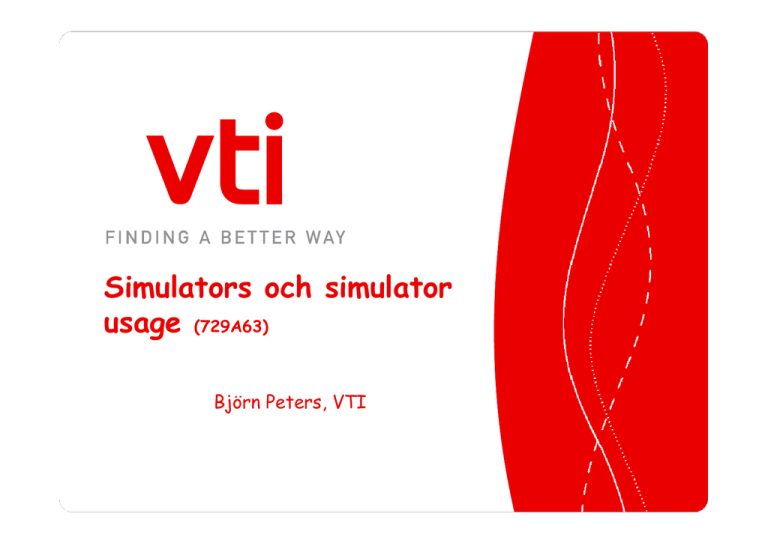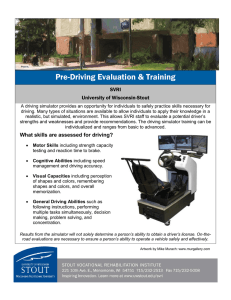Simulators och simulator usage Björn Peters, VTI (729A63)
advertisement

Simulators och simulator usage (729A63) Björn Peters, VTI Agenda Presentation Experiences for last year Some practicalities Visit the simulator Course goals and content • • • • • • • Seminars, literature Project, grouping (3 groups) • Simulator history – short • Discussions on the three articles • Next date and task/paper allocations Presentation of participants • • • • Björn Peters, research leader, course responsible Jonas Andersson Hultgren, research engineer Katja Kircher, researcher Magnus Hjälmdahl, researcher • • • • • • • Johan Brage Ellen Ekström Martin Krampell Caroline Norén Albin Pettersson Veronica Petrovych Ignacio Solís Marcos Experiences from last course (HT 2013) and actions taken • • • • • The project part takes time! Start working on the project early Christmas and New Year was a problem, thus rescheduled Scheduling the simulator usage – Doodle like tool - Jonas Seminars took too much time – too many participants? Some practicalities • Seminars and project execution at VTI • Food and coffee available here. You can also bring your own food. • Ignacio and Veronica already have working places here, possibly we can find places for the rest of you to sit and work • VTI open between 8 and 16 (can be extended if needed) • Name tags from the reception • Project report template and simulator description (what can be done?) will be handed out to you. • Jonas Andersson Hultgren will help you with simulator programming and data • Information on how to start and run the simulator will be provided • We assume you have the statistical tools need for the analysis, if not it can be arranged so you can run from a computer here at VTI Course goals The student should after completed course: • be able to discuss pros and cons with simulators as research tools. • have knowledge about ethical considerations as part of planning simulator studies. • be able to formulate a research question suited for a simulator based study. • be able to plan, conduct, analyze data and report a small scale simulator study. • present and discuss study results orally and in writing Course content The course covers the following elements: • introduction to driving simulators (possibilities and limitations), classification of simulators • study design (experimental design), scenario design and test leader task, selection of participants (exclusion och inclusion criteria), The Project! • validity problems (external and internal) – interpretation of results and conclusions, some examples. • ethical aspects (application for ethical approval) • Simulator based training/education, traffic environment design och hardware-in-the-loop will be briefly addressed. Alternatives? Course literature Parts of these books … … and some other stuff Course literature will be handed out or available on the course web site Seminars • Seminars mandatory – absence extra task • Seminar content - cover what is in the syllabus but some flexibility • All should individually read, present and critically comment one paper (article or book chapter) • If you have specific ideas on papers tell me. • 3 papers per class • 2 presentations (cognitive models, ethics) • Present project ideas before start of experiments The project • • • • • • • • • • • Start early Grouping, 3 groups with 2/3 participants All group participants should contribute Tell me if you encounter any problem within the group Report template Report in Swedish or English Use the template directly when planning Present your experimental plans and get feedback before you start. Oral presentation and review of other group report. Previous projects as examples. Mandatory simulator questionnaire. Schema och kommande aktiviteter • Course Duration until week 43 (24 October) • Today’s papers – comments & criticism? 1. Driving simulators as research tools (Carsten Jamson) 2. A short history of driving simulators (Allen, Rosenthal & Cook) 3. The future of driving simulators (Hancock and Sheridan) • Next class? Dates and time? Once every week at least! • Three papers for next class. 1. Sensory and perceptual factors in the design of simulation displays 2. Psychological fidelity: Perception of risk 3. Simulator validity: behaviors observed on the simulator and on the road. • Volunteers? Simulator history 1910 Flight simulator First commercial simulators 1930 Flight simulator Simulator, 1940’s - electronic 1960 Group training One size fits all? Late 1970 video scenes 1970 Dynamic simulators, model landscapes Part task training – gear shifting 1980 Video projection 1980 ties VTI dynamic simulator with motion base Driving simulator history Daimler Chrysler in Berlin Driving simulator history The NADS simulator The National Advanced Driving Simulator at The University of IOWA Simulator requirements Components of a driving simulator • Visual system • Car controls • Computer with •vehicle model • active feedback • Sound system • Car body • Motion system Simulation - it’s all about illusions Count the number of black spots! Moving or standing still??? The visual system Time to update the image less – should as short as possible (40 – 60 ms) At least 60° * 30° Peripheral vision critical for speed perception 120 ° * 30 ° preferable High resolution and acuity central image less in peripheral image Long delays can cause simulator sickness • Transport delay • Frame rate • Display size • Resolution • Acuity However driving is more than a visual task The literature contains numerous claims that 90% of all the information used in driving is visual. A comprehensive investigation could not find any evidence for this numerical estimate. The proliferation of such claims in the absence of direct evidence is a reminder that researchers should be careful about assuring the validity of the claims they are passing on. Sivak 1996 The sound system Engine Tyres Wind Road texture Velocity dependent approx 20 – 2 kHz 3D sound Critical for speed perception Forces on a vehicle Degree of freedom (DOF) Accelerations limits Vehicle motion Longitudinal -0.6g – +0.4g Braking, accelerating Lateral -0.7g – +0.7g Cornering Vertical -0.8g – +1.1g Suspension and road elevation Roll ± 320°/s2 Suspension and cornering Pitch ± 360°/s2 Suspension and cornering Yaw ± 45°/s2 Steering Max acceleration of a Renault Laguna test vehicle Implementation of force feedback through motion system Roll Pitch Lateral Vibrations Vehicle model Tyre model Suspension model Steering system Feedback to vehicle controls Driving scenarios


